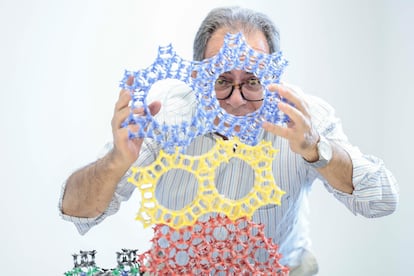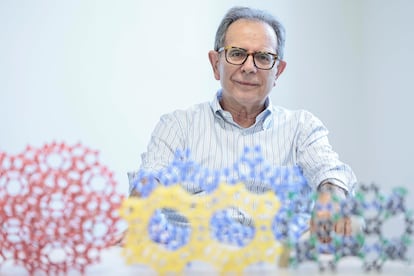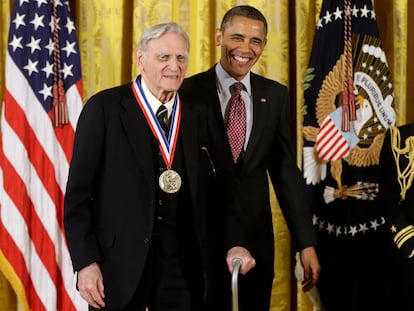Avelino Corma, European inventor of the year: ‘Controlling nuclear fusion would be a giant step towards the future, but it’s always thirty years away’
The Spanish chemist won the European Patent Office award for his more than 200 inventions

For his professional career, which already includes a Prince of Asturias prize, awarded in 2014, chemist Avelino Corma has been named inventor of the year by the European Patent Office. His inventions, the more than two hundred patents that he and his Institute of Chemical Technology (ITQ) have accumulated, are actually discoveries applied to real life. Corma has always thought that scientific excellence might also have a practical utility, and this Tuesday, these “guerrillas of science,” as they have been dubbed, received a new accolade at the awards ceremony in Valencia (Spain).
Question: Are you an inventor?
Answer: Well, I am a researcher trying to understand how chemical reactions happen and how they can be modified. In these studies, we sometimes see that the results could have an application and we patent them. Then we publish them like any scientific discovery, but we have patented them first. Nowadays, people don’t say inventor much, but it is true that they are patents of invention so, in that sense, you can say that you have invented something.
Q. Is that what you were born to do?
A. In general, all good researchers are very curious. They all ask questions. Then there is one more component, which some have, and others do no. And that is that in view of the results, you take the step back and say ‘yes, now I would change this and then it could serve to solve that problem.’ Although there are disciplines in which it is more difficult, of course.
Q. Were you curious as a child?
A. Very. Very curious. I was very inquisitive and I still am now. I remember going to the countryside with my father when I was eight or nine years old and I had to understand everything he told me very well, and then I would look at things and ask him questions about everything. Later, in high school, I set my own problems, made my own hypotheses and experiments.
Q. Why is it important to control chemical reactions and what is the role of catalysts?
A. They are a way to direct the reaction where you want it to go. They increase the speed of the reaction and when there are several options, they allow it to be directed towards one or the other. What you are looking for are selective catalysts, because if you want a reaction to result in product A but also give product B and C, surely these will be by-products that you don’t want at all and may even be pollutants and cause problems.
Q. What was the history of your first catalyst? The one that is still being talked about ....
A. The CEPSA one. I was working on zeolites, a type of catalyst, studying the cracking of heavy crude oil fractions. It was about breaking hydrocarbon chains with catalysts. Then CEPSA (Spanish petroleum company) came along, which was fantastic just to be approached, and presented us with a problem: at the refinery, there was a stream whose octane number they wanted to increase, but in doing so a significant amount of hydrocarbons were being broken down into smaller hydrocarbons.
Q. What was the solution?
A. We saw a way of transforming the hydrocarbons of that fraction without breaking them, simply by rearranging the carbons of these compounds, giving rise to products of much higher octane rating, something we call isomerization. We started working with zeolites, seeing which was the best and how they had to be set up and modified. The results were good and CEPSA checked our results and decided to use it in a larger plant. It worked very well and it was decided to go to a commercial process at a large chemical plant, as was appropriate for a large chemical process. It went very well, it was very competitive and CEPSA has licensed it to several international companies and it is still being applied in about twenty plants.

Q. What does public research imply in the context of a capitalist economy?
A. It is fundamental for many reasons, but for two above all. It allows research on topics that may not have an application today or that we do not see today, but the day after tomorrow we will still need the knowledge that was found, as has happened with the vaccine technology [of Covid-19]. In any case, progress is made in knowledge, which is key to human development. But the state must also have its own science policy, it must make decisions on which areas it wants to put more resources into. Today, in decarbonization, for example, and part of the public research must go in this direction.
Q. Speaking of situations that are ahead of their time, you were ahead of the curve with biomass...
A. We have been working with biomass to obtain chemical products for almost thirty years. We published it and nobody was interested in that work. Later we worked on trying to replace part of the fossil fuels with biomass derivatives and we got as far as a demonstration plant in Texas (U.S.A.), but at that time the legislation was much less restrictive and it was more expensive than obtaining the derivatives from non-renewable sources. Now, companies are facing much stricter legislation and have been forced to develop all this technology very quickly.
Q. In 1990, you created the Institute of Chemical Technology of the Universitat Politècnica de València and CSIC. What does it mean to you?
A. The founding idea was that we had to do excellent research, but we also wanted to try to extrapolate it to the productive system. That’s how we started and that’s how we continue. That is my legacy. When I speak of “science guerrillas” it is because my group and I have always followed that line, we have never belonged to any pressure group. For example, in the beginning, there were people working in basic science who saw us as applied, as not pure, but we continued with our dual program.
Q. We are undergoing an accelerated process of decarbonization, does this involve reducing emissions or capturing them?
A. Everything. The goal is to reach zero net CO₂ emissions, the balance has to be kept at least as it is, and if possible, it has to go down. We will get there as best we can. We don’t want fossil hydrocarbons, we don’t want carbon compounds that come from fossils, but we have a lot of molecules that are part of our daily life that are made up of carbon and hydrogen. Where do we get the carbon? Right now, it’s oil, gas, and coal. Where can we obtain non-fossil carbon? From plants, which have captured CO₂ from the atmosphere and transformed it into biomass. Another way is to use the CO₂ coming out of the chimneys, which we will now capture and, using green hydrogen, transform into molecules containing carbon and hydrogen. However, we have to think about how to do it without burning fossil resources when they are all renewable. In that case, we will use biomass, which has captured CO₂ by transforming it, and if we don’t have enough, which we won’t, we will have to capture CO₂ from the atmosphere. To do this, we will need to develop technology that can adsorb it from the gas mixture in which it is found in very low concentration, absorb it, concentrate it and transform it into products.
Q. What would the ideal energy development look like in the coming decades?
A. First and foremost, we have to generate enough renewable energy. At the moment it is still not enough, but it will become more profitable when cars no longer run on gasoline or diesel and factories stop using natural gas. Secondly, and in parallel, we need to find solutions that allow us to accumulate all the wind and solar energy that is produced in excess at specific times so that it can be used at times when there is no shortage in the supply of solar energy. We need technology to store all this energy. At midday you can have a large peak of solar energy production, which you are not going to use and which can be stored.
Q. What do you suggest to help achieve this?
A. We think one way is to convert this energy into chemicals. From CO₂ and hydrogen you can make methanol, which is a liquid that you can transport and use to produce thermal energy when you need it. Or you can make methane and it can be injected into existing gas pipelines. We can also produce hydrogen, which we either use close to the production site or we will have to store and transport it at high pressures.
Q. In December, the Lawrence Livermore Laboratory in the United States announced that it had produced more energy than it had spent on nuclear fusion ... is that a true path or one yet to be explored?
A. That would be the great move for the future, the definitive solution. If we could control it, we would have energy when we wanted it and it would be continuous. But we are not there yet. Every time we ask specialists, they tell us that we are still thirty years away. Now, I would stake my name on it being within the next thirty years. Today everything is moving much faster and the odds are increasing that it will become a reality.
Q. The EU ban on the sale of new combustion vehicles as we know them today is twelve years away, is there an alternative?
A. Assume there will be compliance and don’t declare moratoriums. The way for us to comply with this model of car use, as it looks like it is going to be, would be to have enough batteries on the one hand; hydrogen on the other; and methanol and also gasoline, diesel and kerosene, the latter generated solely from green CO₂ and hydrogen, obtained from biomass. Because this way, even if these fuels are used in combustion engines, they will not generate additional CO₂. The CO₂ emitted will be equal to the CO₂ consumed in its production: there will be a zero CO₂ balance. I believe that all the solutions will go together, because the problem is so big that it is difficult to think that a single solution will provide an answer to a problem of this magnitude.
Q. Artificial intelligence has burst into all areas in recent months, how do you get along with it?
A. It is already being very helpful in our research. If used correctly, it represents a breakthrough. But, as in other fields, our society will have to protect itself with laws against the possible uses of this technology.
Q. What does this award from the Patent Office mean to you?
A.There are 200 European patents, but we also have patents that we have extended in America and Japan. They are patent families, they are not all different. For us, the most important thing is that our fundamental principle has been recognized: we do basic scientific excellence, this has been recognized in many places, but at the same time much of this science can be transferred to solve society’s problems. We’ve hit our target.
Q. Are you looking forward to retirement?
A. Yes and no. Now I get much more tired than before. You can’t imagine how busy I was before. Now I can’t get to everything. There are times when I’m really tired I think “go on, go home.” But at the same time, I remain curious; and at six o’clock this morning, I was thinking about a problem and at seven o’clock I was sending messages to my team.
Q. How do you cope with fame? I should be used to it by now, after the 2014 Prince of Asturias prize, shouldn’t I?
A. I am doing well, the important thing is still research and work. I am a professional. It was similar then. The award was a very pleasant surprise.
Q. Now there’s talk of a Nobel ...
A. No, we don’t talk about that.
Sign up for our weekly newsletter to get more English-language news coverage from EL PAÍS USA Edition
Tu suscripción se está usando en otro dispositivo
¿Quieres añadir otro usuario a tu suscripción?
Si continúas leyendo en este dispositivo, no se podrá leer en el otro.
FlechaTu suscripción se está usando en otro dispositivo y solo puedes acceder a EL PAÍS desde un dispositivo a la vez.
Si quieres compartir tu cuenta, cambia tu suscripción a la modalidad Premium, así podrás añadir otro usuario. Cada uno accederá con su propia cuenta de email, lo que os permitirá personalizar vuestra experiencia en EL PAÍS.
¿Tienes una suscripción de empresa? Accede aquí para contratar más cuentas.
En el caso de no saber quién está usando tu cuenta, te recomendamos cambiar tu contraseña aquí.
Si decides continuar compartiendo tu cuenta, este mensaje se mostrará en tu dispositivo y en el de la otra persona que está usando tu cuenta de forma indefinida, afectando a tu experiencia de lectura. Puedes consultar aquí los términos y condiciones de la suscripción digital.
More information
Últimas noticias
More than 40 Democratic lawmakers urge Trump in a letter to stop his ‘attempts to undermine democracy in Brazil’
The journal ‘Science’ criticizes Trump’s anti-renewable energy policy: ‘The US is failing to benefit from its own innovations’
Cubans hope for a miracle as dengue and chikungunya spread
The long shadow of the father figure in the films of Rob Reiner
Most viewed
- Christian Louboutin: ‘Young people don’t want to be like their parents. And if their parents wear sneakers, they’re going to look for something else’
- Cartels in Mexico take a leap forward with narco-drones: ‘It is criminal groups that are leading the innovation race’
- ‘El Limones’ and the growing union disguise of Mexican organized crime
- Liset Menéndez de la Prida, neuroscientist: ‘It’s not normal to constantly seek pleasure; it’s important to be bored, to be calm’
- The low-cost creative revolution: How technology is making art accessible to everyone










































